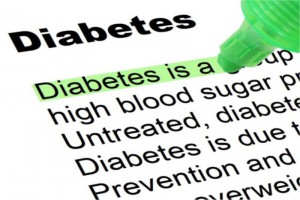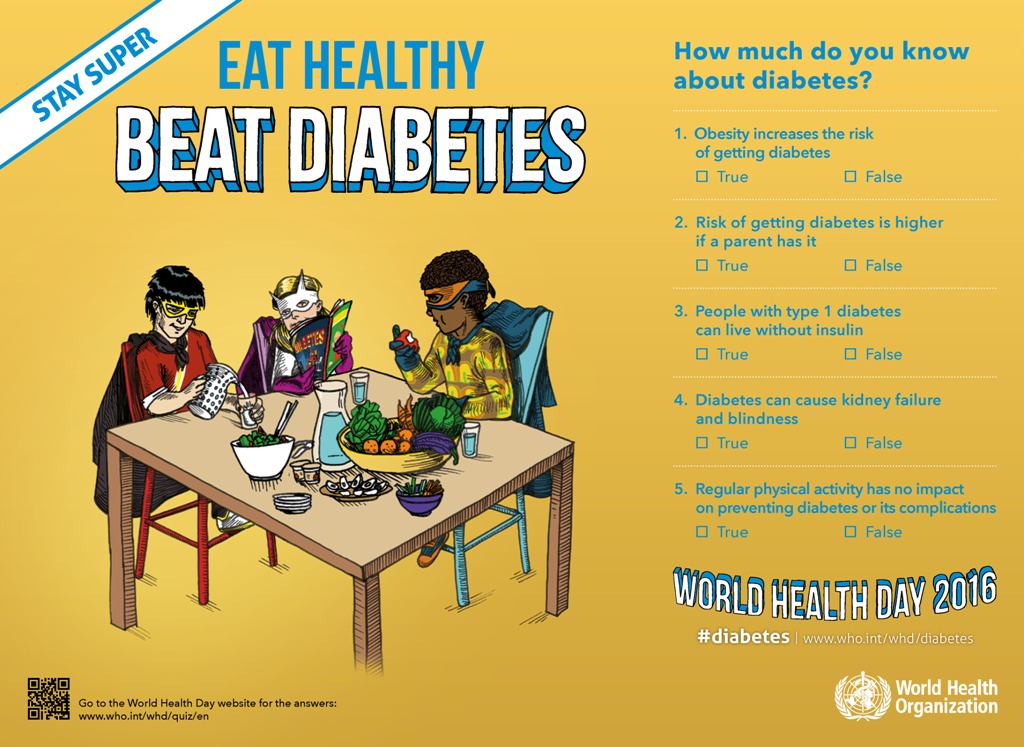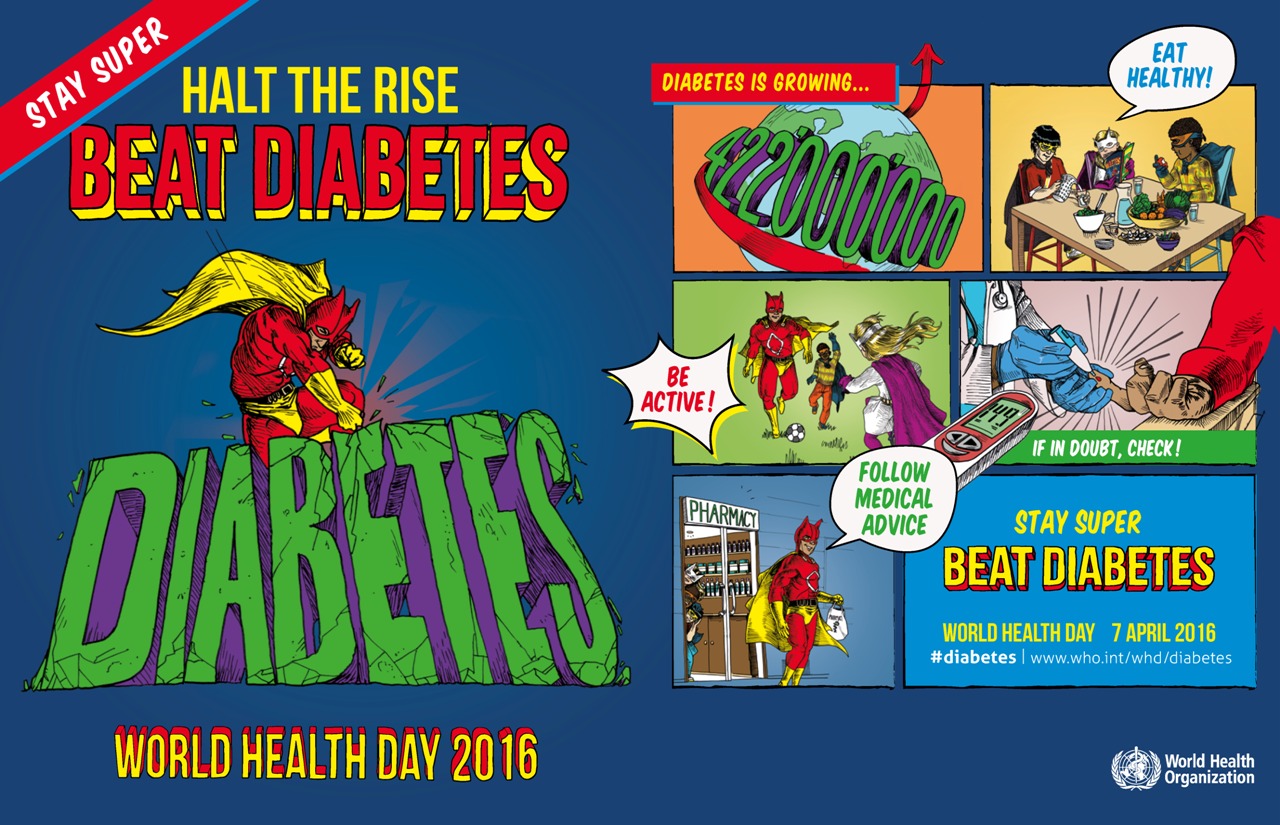World Health Day is celebrated on the 7th day of April every year to promote awareness to different health topics. This year, the theme of World Health Day 2016 is “Beats Diabetes” which focus on the rising tide of diabetes worldwide.
According to World Health Organization (WHO), an estimated 347 million people in the world had diabetes in 2008 and the prevalence is growing, particularly in low and middle income countries. In 2012, the disease was the direct cause of some 1.5 million deaths, with more than 80% of those occurring in low- and middle-income countries. In 2014 the global prevalence of diabetes was estimated to be 9% among adults aged 18+ years. WHO projects that diabetes will be the 7th leading cause of death by 2030.
What is diabetes?
 Diabetes is a chronic disease that occurs either when the pancreas does not produce enough insulin or when the body cannot effectively use the insulin it produces. Insulin is a hormone that regulates blood sugar. Hyperglycaemia, or raised blood sugar, is a common effect of uncontrolled diabetes and over time leads to serious damage to many of the body’s systems, especially the nerves and blood vessels.
Diabetes is a chronic disease that occurs either when the pancreas does not produce enough insulin or when the body cannot effectively use the insulin it produces. Insulin is a hormone that regulates blood sugar. Hyperglycaemia, or raised blood sugar, is a common effect of uncontrolled diabetes and over time leads to serious damage to many of the body’s systems, especially the nerves and blood vessels.
How many type of diabetes?
There are two major forms of diabetes. Type 1 diabetes is characterized by a lack of insulin production and requires daily administration of insulin The cause of type 1 diabetes is not known and it is not preventable with current knowledge. Symptoms include excessive excretion of urine (polyuria), thirst (polydipsia), constant hunger, weight loss, vision changes and fatigue. These symptoms may occur suddenly.
Type 2 diabetes results from the body’s ineffective use of insulin, largely the result of excess body weight and physical inactivity and comprises 90% of people with diabetes around the world. Symptoms may be similar to those of Type 1 diabetes.
A third type of diabetes is gestational diabetes, is characterized by hyperglycaemia, or raised blood sugar, with values above normal but below those diagnostic of diabetes, occurring during pregnancy. Women with gestational diabetes are at an increased risk of complications during pregnancy and at delivery. They are also at increased risk of type 2 diabetes in the future.
What are common consequences of diabetes?
Over time, diabetes can damage the heart, blood vessels, eyes, kidneys, and nerves.
- Diabetes increases the risk of heart disease and stroke – study found 50% of people with diabetes die of cardiovascular disease (primarily heart disease and stroke).
- Combined with reduced blood flow, neuropathy (nerve damage) in the feet increases the chance of foot ulcers, infection and eventual need for limb amputation.
- Diabetic retinopathy is an important cause of blindness, and occurs as a result of long-term accumulated damage to the small blood vessels in the retina. 1% of global blindness can be attributed to diabetes.
- Diabetes is among the leading causes of kidney failure.
- The overall risk of dying among people with diabetes is at least double the risk of their peers without diabetes.
What are the prevention & treatments of diabetes?
Prevention
Simple lifestyle measures have been shown to be effective in preventing or delaying the onset of type 2 diabetes. To help prevent type 2 diabetes and its complications, people should:
- achieve and maintain healthy body weight;
- be physically active – at least 30 minutes of regular, moderate-intensity activity on most days. More activity is required for weight control;
- eat a healthy diet of between 3 and 5 servings of fruit and vegetables a day and reduce sugar and saturated fats intake;
- avoid tobacco use – smoking increases the risk of cardiovascular diseases.
Related:
6 Simple Habits to Live a Healthy Life;
Healthy Eating Pattern Recommended by the New USDA Dietary Guidelines;
The Secret to a Better and Longer Life
Diagnosis & treatment
Early diagnosis can be done through blood testing. Treatment involves lowering blood glucose and the levels of other known risk factors that damage blood vessels. Tobacco use cessation is also important to avoid complications. Treatment interventions include:
- moderate blood glucose control. People with type 1 diabetes require insulin; people with type 2 diabetes can be treated with oral medication, but may also require insulin;
- blood pressure control;
- foot care;
- screening and treatment for retinopathy (which causes blindness);
- blood lipid control (to regulate cholesterol levels);
- screening for early signs of diabetes-related kidney disease.
How to support the cause?
Share your stories, or advice, on measures that can be taken to prevent and manage diabetes. You can also take the WHO diabetes Quiz: How much do you know about diabetes? and share your answers via Twitter and facebook (#Diabetes).

Source/Cover Image: World Health Organisation










